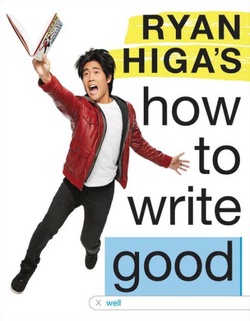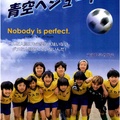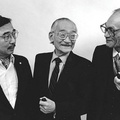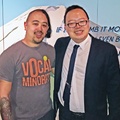In early 2005, when Facebook was fighting for dominance against a rival called MySpace — and before “social media” became part of our daily routine, another website that would become a huge part of the quotidian lives of young people was launched by tech alums Chad Hurley, Steve Chen, and Jawed Karim.
Their video sharing site was called YouTube.
YouTube allowed anyone with the basic tools of the digital age to upload and share videos, be it a laughing baby, a curious cat or clips of copyrighted materials, which of course alarmed traditional media companies that barbarians — i.e., their potential customers — were storming the vaults of their treasured intellectual property, launching lawsuits against the nascent company.
Nevertheless, a slightly older tech company named Google (now Alphabet) bought YouTube in late 2006 for $1.65 billion, a figure that in 2017 looks like a bargain — not that Hurley, Chen, and Karim are complaining about being set financially for life. In 2017, YouTube is a media force that has evolved to the point it has a subscription channel, YouTube Red, which feature original content, including an upcoming Karate Kid spinoff featuring Ralph Macchio and Billy Zabka. (see “INTO THE NEXT STAGE: ‘Cobra kai’ — Coming to a Dojo Near You”)
In a case of right-place, right-time circumstances, one of the unintended consequences of the birth of YouTube was that it would become a boon to a subset of the tech-savvy Millennial generation: young Asian Americans.
* * * * *
Like newspapers and radio before them, the two most-influential forms of mass media — television, followed by motion pictures — since their respective beginnings had high barriers to entry, mainly due to the costs involved in building a TV network or producing and distributing a movie. Just the necessary equipment required substantial capital investments.
As for the talent that appeared in the television shows and movies, their respective gatekeepers, from the casting directors to the producers — perhaps on purpose, perhaps due to ignorance — didn’t go out of their way to include other Americans who failed to fit the stereotype of what a “real American” should look like.
While the situation has improved, thanks to external and internal pressures and demographic changes, vexing problems related to that history continue, like pay equity for Asian American cast members in Hawaii Five-0 or like in the case of Ghost in the Shell, a Hollywood stubborn insistence on shoehorning in a White American into a lead role that should have been played by (some sort of) an Asian actress.
YouTube, born in this new century and new millennium, leapfrogged the traditional, institutional barriers to access to TV and movies, just like blogging and podcasting have allowed new voices traditional newspapers and radio kept at bay.
With comparatively cheap distribution means (the Internet) and relatively inexpensive but high-quality tools (digital video cameras, computers, editing software), someone — anyone — with initiative, ambition, drive and free-time could become a YouTube star.
Enter Ryan Higa.
The Hilo, Hawaii, native started posting his homebrew videos in 2006, making him a pioneer in the world of YouTube stars — many of whom, if you don’t have an adolescent in your household, you may have not heard of. (Does PewDiePie ring a bell? Can you even pronounce it properly?!)
Higa’s specialty is comedy. He’s clever and talented, and not mean or offensive. My kids, Akari and Jameson, like him, especially J.J. Like many in their age group, they don’t watch much “regular” TV — for them, it’s offerings on YouTube, Netflix, and Apple TV, with occasional injections from CW shows like The Flash. I’m actually happy they and other Asian Americans kids can watch another Asian American in Higa, who left Hilo for Las Vegas a few years ago and seems to be content living on the mainland, within striking distance of Hollywood.
For young Asian American YouTubers like Higa — Michelle Phan, Kevin Wu, Freddie Wong, Vivian Vo-Farmer, Mark Fischbach, Eugene Lee Yang, Jenny Yang — who caught on to YouTube, they could become stars — well, Internet stars, at least — without the need for “permission” from traditional gatekeepers.
As for Higa, 27, he’s been at or near the top of the YouTube game for a long time in Internet years and has amassed nearly 24 million subscribers to his YouTube channel. While he is a bona-fide Internet star, he is not a household name — but he could be. Maybe that’s why he authored a book: Ryan Higa’s How to Write Good (copyright 2017, published by Little, Brown and Company, with a suggested retail price of $19.99), so he can start to expand beyond being a “mere” Internet star. (Thanks to James Ito for alerting me to this new book!)
Despite the comedic title, the book is not so much a treatise on the mechanics of writing as it is a memoir of his recollections of growing up in Hilo (which doesn’t come off that well), dealing with kid problems like school and being bullied, having an older brother, parents who put him into a different school for his own good, etc. While it’s funny, there are actually some serious themes in it. (My son said he likes the book.) It combines prose with comic book-style graphics and is very meta in its approach. (I like it, too.)
So yes, at the ripe old age of 27, maybe this book is a signal that Higa is ready for the next step for his career. Like I said, he lives in Las Vegas and Hollywood is a possibility. He’s also smart, funny, and handsome and comes with a built-in, gigantic fan base.
But Hollywood’s track record for Asian Americans and Asians has been dismal. It really would take the right project for him to take his career into the next stage. It would be great for him to solidify his connection with his Japanese American and Asian American fan base and cross that over into the mainstream. Maybe next year he could be the Nisei Week Parade’s grand marshal. I’d bet that would goose attendance big time and help build bridges with the extant Japanese American and Asian American community here. If he hasn’t already been asked, why not try?
The aforementioned MySpace is now a punchline for Internet failures. But thanks to YouTube, Ryan Higa is getting bigger laughs. Tee hee, indeed.
* This article was originally published on The Rafu Shimpo on August 29, 2017.
© 2017 George Johnston






